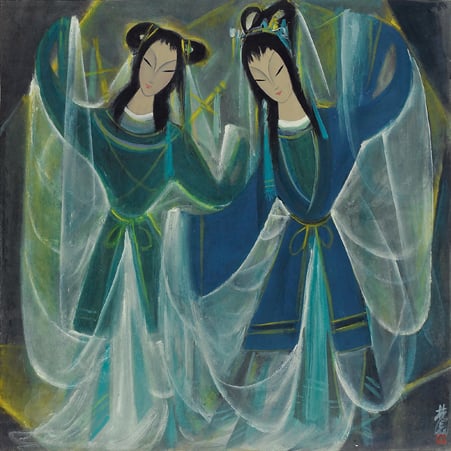
Lin Fengmian, Legend of the white snake, 26 x 26 in., Sold at Sotheby’s Hong Kong for 1,700,000 HKD (219,490 USD) in 2009. Lady White is always accompanied by Lady Green, who is also a snake spirit and was once saved by the White Snake. Lady Green thus regards Lady White as an older sister.
February 10 marked the beginning of the Year of the Snake in the Chinese astrological cycle, and it is easy to see that the snake has returned to the spotlight as a source of inspiration for the new year. From the shiny designs of serpents wrapping the entire Bulgari building on Fifth Avenue to MAC’s Year of the Snake makeup collection, the snake is sure to bring a dose of style to 2013.
Tale of the White Snake by Ye Qianyu
Wu Tong, The white snake, 2011, 37 1/2 x 26 3/8 x 14 3/8 in., Sold at China Guardian Auctions for 57,500 CNY (9,217 USD) in 2012
Amongst all of the 12 zodiac animals, the snake stands out for its enigmatic personality in ancient tales of almost every culture. When it comes to Chinese snake folklore, there is no other story that can compete with the popularity of The Legend of the White Snake. This legend constantly inspires various genres of art, and appears frequently in novels, operas, films, and TV series. Artworks that depict the White Snake have been auctioned off at major auctions houses, including Bonhams and Christie’s. This folklore is not only popular among Chinese people, but brings inspiration to the West as well. Two of the most recent productions, which both took place in 2012, were The White Snake at Berkeley Rep, by Tony Award–winning director Mary Zimmerman, and The Legend of Lady White Snake: A Tribute to the Spirit of Alexander McQueen, a short film directed by Indrani Pal-Chaudhuri. The latter is postmodern, and sets this ancient Chinese legend in contemporary New York City.
Wang Luhuan, “White Snake” Balin Stone Ornament, 2003, Sold at China Guardian Auctions for 425,600 CNY (60,713 USD) in 2008. This work depicts the beginning and end of The Legend of the White Snake.
A double-overlay glass ‘Legend of the White Snake’ snuff bottle, Qing dynasty, 2 3/8 in., Sold at Bonhams Hong Kong for 112,500 HKD (14,515 USD) in 2012. The scene on this snuff bottle depicts the first time Lady White meets Xu Xian.
The sources of the legend remain obscure, but the story itself predates any of these forms. It existed in oral tradition long before any written compilations, and was handed down from the Tang and Five Dynasties, around the 7th to the 10th century in China.
A LARGE CARVED AND PIERCED IVORY TUSK, Qing Dynasty, 28 in., Sold at Christie’s South Kensington for 25,000 GBP (39,469 USD) in 2012. The intricate carvings on this tusk depict a battle scene between Lady White and monk Fahai in front of Jin Shan Temple.
The adventurous and romantic story is about a local pharmacist, called Xu Xian, who falls in love with a snake spirit, disguised as a beautiful young woman. The snake spirit has been living on the Mount Emei for thousands of years; she becomes enlightened through her efforts in meditating and disciplining herself, and thus accumulates enough power to take human form. She comes down from the mountain to spend one day on earth to find out what it’s like to be a human being. She runs into Xu Xian on her visit to the West Lake, and she becomes very enchanted by this polite, kind, and handsome man. They have a quick romance and get married. However, this is not a happy event to a Buddhist monk, Fahai, who disapproves strongly of anyone who marries a member of a different species. Fahai tries to break them up in various ways, and the couple is eventually separated. The snake spirit ends up trapped under a pagoda near the West Lake as a punishment. Some versions say that she’s later released by her son, whose father is her human husband, and the family is reunited at last.
A Pair of Chinese Octagonal Bowls, Republic Period, 4 ¾ in., Sold at Christie’s South Kensington for 3,250 GBP (5,367 USD) in 2011. This piece depicts another battle scene from The Legend of the White Snake.
Although a theatrical piece, this epic tale became a classic theme for visual art forms as well; representations of the folklore can be found in scrolls, porcelain, and various carvings. Above is a selection of Chinese artworks, from the artnet Price Database, which are inspired directly by this Legend of the White Snake.
Dai Ronghua, A gucai figure vase, 2007, 14 in., Sold at Beijing Council International Auction for 977,500 CNY (156,922 USD) in 2012. When the two figures first meet, Xu Xian lends Lady White his umbrella when it starts to rain. The umbrella thus becomes a token of their love.